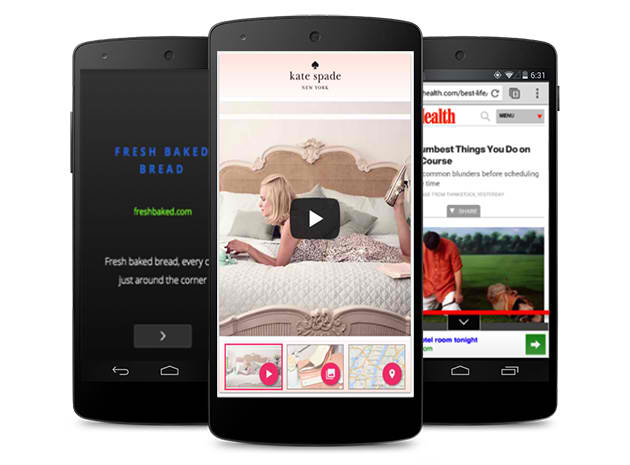
Google is introducing new ad formats meant to span different screen sizes and types. This is meant to address the disparity between displaying ads on desktop and mobile devices, and is supposed to make the ad-viewing experience more pleasant for smartphone and tablet users.
As mobile devices become more ubiquitous, people increasingly access websites, rich media and other content on their smartphones and tablets, among other devices. This means usage on bigger screen devices like laptops and desktops is reduced, thereby also reducing the predictability of how content appears on the screen. This can be a headache for marketers and designers, alike, who usually have to consider different screen sizes and orientations when building content.
As of this year, 55 percent of Internet usage in the US comes from mobile devices. Of this figure, 47 percent comes from mobile apps, while the remaining 8 percent accounts for mobile web, according to data from comScore. “Marketing has always been about being active where viewers spend most of their time and this attention is diminishing in traditional media,” says GetResponse marketing chief Hanna Andrzejewska in an interview with Android Authority. “As mobile devices and apps become more popular, there is a need to shift to formats that can adapt to different screen sizes with the goal of high conversion via intuitive user experience.”
This means apps are still king when it comes to accessing content and information online, and advertisers need a better way to market their content than the simple bottom-screen banner.
As per Google’s Inside Adwords blog, the company will be launching several new ad formats via the Google Display Network, AdMob Network and DoubleClick, which will “make it easier for advertisers to build successful ads that work across screens.”
- Big brand ads. The first type involves big brand ads, which are built for mobile and can be dynamically resized for any screen. This ad type comes in compressed and expanded state, and will feature an adaptive design that will adjust according to the user’s device and layout.
- Video ads for AdMob. Meant to provide a richer ad viewing experience, TrueView ads will expand coverage beyond the current gaming apps they appear on. According to Google, these ads “can reach consumers while they engage with their favorite apps,” and advertisers only pay when the user does not click the “skip” button.
- Anchor ads. This type of ad sticks to the bottom of the user’s screen, so it does not disappear even when you scroll.
- Magazine style. Previously launched for mobile websites, this feature will now appear within apps that use the Google Display Network platform.
What this means for businesses
According to Noah Elkin, principal analyst at eMarketer, smartphones “play a privileged role in driving always-on commerce,” referring to how users are always-on and always-social. Businesses can therefore take advantage this trend of sending their message across through ads that appear on mobile devices.
These new ad formats will make it easier for businesses, marketers and advertisers to bring their message across. Google Display Network will feature an auto resizing tool that will dynamically format the advertisements depending on the screen size. Google’s ad platforms also offer automatic Flash-to-HTML5 conversion for devices that don’t support Flash, which ensures an interactive version of the ad appears instead of a static one.
Google also promises to make it easier to make rich media ads through templates. DoubleClick Studio Layouts is a tool that lets marketers upload their creative assets into pre-built rich media ad templates that work on smartphones and tablets.
What this means for users
Ads can be obtrusive, although well-designed ad formats and content can actually be entertaining and interesting. Admit it — if you’re fond of watching funny and attractive commercials on TV, then chances are you might also appreciate seeing similar advertising on mobile devices. At least these will be more forgivable than ugly odd-shaped ad formats that either block the screen or become a pain in the eyes.
However, there is also a likelihood that in-app advertisements might intrude on an otherwise great app experience. This is a big tradeoff when using free-to-download apps, in which the developers rely on ad revenue to earn.
The question at this point is this: what will users think of these new in-app ad formats? Will smartphone and tablet users be forgiving of ads if these pop up within mobile applications as rich, attractive and interactive media?
Source: Inside Adwords;





Leave A Comment